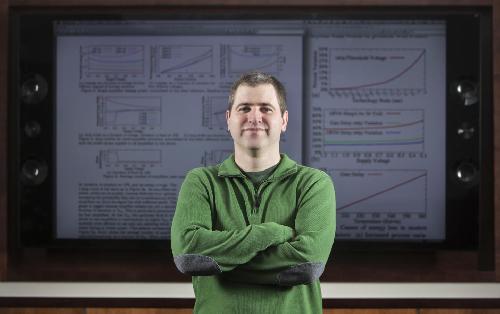BINGHAMTON, N.Y. - Researchers at Binghamton University have become the first to use an open-source graphics processor unit (GPU) for research.
Binghamton University computer science assistant professor Timothy Miller, Aaron Carpenter and graduate student Philip Dexterm, along with co-author Jeff Bush, have developed Nyami, a synthesizable graphics processor unit (GPU) architectural model for general-purpose and graphics-specific workloads. This marks the first time a team has taken an open-source GPU design and run a series of experiments on it to see how different hardware and software configurations would affect the circuit's performance.
According to Miller, the results will help other scientists make their own GPUs and push computing power to the next level.
 Binghamton University computer science assistant professor Timothy Miller co-author developed Nyami, a synthesizable graphics processor unit (GPU) architectural model for general-purpose and graphics-specific workloads. Credit: Jonathan Cohen, Binghamton University
Binghamton University computer science assistant professor Timothy Miller co-author developed Nyami, a synthesizable graphics processor unit (GPU) architectural model for general-purpose and graphics-specific workloads. Credit: Jonathan Cohen, Binghamton University
"As a researcher, it's important to have tools for realistically evaluating new ideas that may improve performance, energy efficiency, or other challenges in processor architecture," Miller said. "While simulators may take shortcuts, an actual synthesizable open source processor can't cut any corners, so we can say that any experimental results we get are especially reliable."
GPUs have existed for about 40 years and are typically found on commercial video or graphics cards inside of a computer or gaming console. The specialized circuits have computing power designed to make images appear smoother and more vibrant on a screen. There has recently been a movement to see if the chip can be applied to non-graphical computations such as algorithms processing large chunks of data.
"We weren't necessarily looking for novelty in the results, so much as we wanted to create a new tool and then show how it could be used," said Carpenter. "I hope people experiment more effectively on GPUs, as both hobbyists and researchers, creating a more efficient design for future GPUs."
The open-source GPU that the Binghamton team used for their research was the first of its kind. Although thousands of GPUs are produced each year commercially, this is the first that can be modified by enthusiasts and researchers to get a sense of how changes may affect mainstream chips. Bush, the director of software engineering at Roku, was the lead author on the paper.
"It was bad for the open-source community that GPU manufacturers had all decided to keep their chip specifications secret. That prevented open source developers from writing software that could utilize that hardware," Miller said. Miller began working on similar projects in 2004, while Bush started working on Nyami in 2010. "This makes it easier for other researchers to conduct experiments of their own, because they don't have to reinvent the wheel. With contributions from the 'open hardware' community, we can incorporate more creative ideas and produce an increasingly better tool."
The ramifications of the findings could make processors easier for researchers to work with and explore different design tradeoffs. Dexter, Miller, Carpenter and Bush have paved a new road that could lead to discoveries affecting everything from space travel to heart surgery.
"I've got a list of paper research ideas we can explore using Nyuzi [the chip has since been renamed], focusing on various performance bottlenecks. The idea is to look for things that make Nyuzi inefficient compared to other GPUs and address those as research problems. We can also use Nyuzi as a platform for conducting research that isn't GPU-specific, like energy efficiency and reliability," Miller said.
The paper, "Nyami: A Synthesizable GPU Architectural Model for General-Purpose and Graphics-Specific Workloads" appeared in International Symposium on Performance Analysis of Systems and Software.
source: Binghamton University